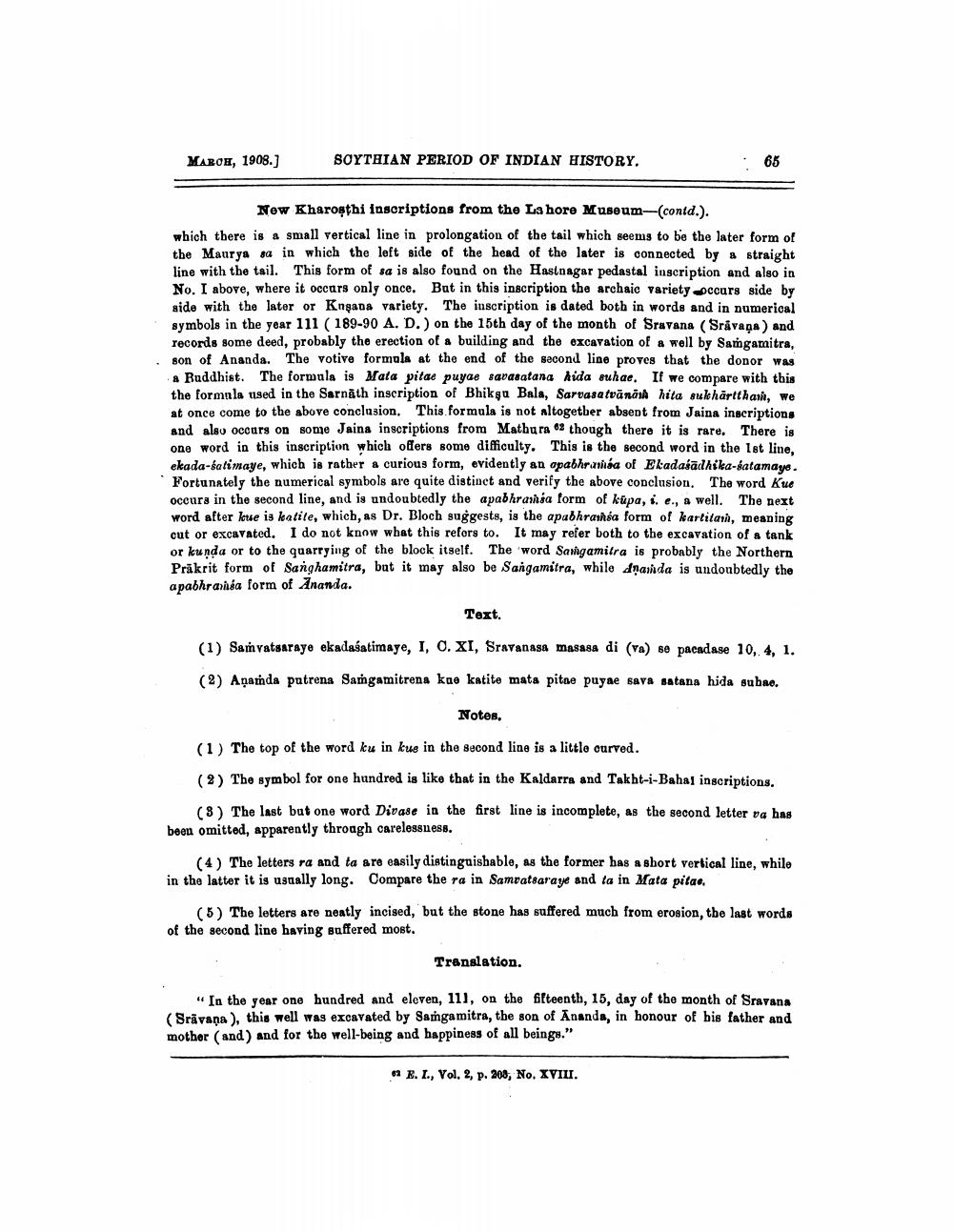________________
MAROH, 1908.]
SOYTHIAN PERIOD OF INDIAN HISTORY.
65
Now Kharofthi Inscriptions from the La hore Museum-(contd.). which there is a small vertical line in prolongation of the tail which seems to be the later form of the Maurya sa in which the left side of the head of the later is connected by a straight line with the tail. This form of sa is also found on the Hasinagar pedastal inscription and also in No. I above, where it occurs only once. Bat in this inscription the archaic variety occurs side by side with the later or Knşada variety. The inscription is dated both in words and in numerical symbols in the year 111 (189-90 A. D.) on the 15th day of the month of Sravana (Srävapa) and records some deed, probably the erection of a building and the excavation of a well by Samgamitra, son of Ananda. The votive formula at the end of the second line proves that the donor was
Buddhist. The formula is Mata pitae puyae savasatana Aida suhae. If we compare with this the formnla used in the Sarnath inscription of Bhikgu Bale, Sarvasatvānāsih hita sukhartthan, we at once come to the above conclusion. This formula is not altogetber absent from Jaina inscriptions and also occurs on some Jaina inscriptions from Mathura e though there it is rare. There is one word in this inscription which offers some difficulty. This is the second word in the 1st line, ekada-fatimaye, which is rather & curious form, evidently an apabhrunisa of Etadašādhika-satamaye. Fortunately the numerical symbols are quite distinct and verify the above conclusion. The word Kue oceurs in the second line, and is undoubtedly the apabhrashsa form of kupa, i. e., a well. The next word after kue is katite, which, as Dr. Bloch suggests, is the apabhrathéa form of kartita, meaning cut or excavated. I do not know what this refers to. It may refer both to the excavation of a tank or kunda or to the quarrying of the block itself. The 'word Sawgamitra is probably the Northern Prākrit form of Sanghamitra, but it may also be Sangamitra, while dņanda is undoubtedly the apabhrarasa form of Ananda.
Text.
(1) Samvatsaraye ekadasatimaye, I, O. XI, Sravanasa masasa di (va) se pacadase 10, 4, 1. (2) Aņamda patrena Samgamitrena kae katite mata pitae puyae sava satana hida subae.
Notes,
(1) The top of the word ku in kus in the second line is a littlo ourved.
(2) The symbol for one hundred is like that in the Kaldarra and Takht-i-Bahaj inscriptions.
(9) The last but one word Divase in the first line is incomplete, as the second letter va has boon omitted, apparently through carelessness.
(4) The letters ra and ta are easily distinguishable, as the former has a short vertical line, while in the latter it is usually long. Compare the ra in Samvatsaraye and ta in Mata pitae.
(5) The letters are nently incised, but the stone has suffered much from erosion, the last words of the second line having suffered most.
Translation.
"In the year one hundred and eloven, 111, on the fifteenth, 15, day of the month of Sravana (Sravana), this well was excavated by Samgamitra, the son of Ananda, in honour of his father and mother (and) and for the well-being and happiness of all beings."
"1 E.I., Vol. 2, p. 208, No. XVIII.




